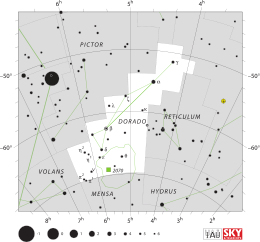astro.wikisort.org - Stella
Gamma Doradus (γ Doradus / γ Dor) è una stella della costellazione del Dorado, la terza più luminosa dopo α Doradus e β Doradus, distante circa 66 anni luce. È il prototipo della classe di stelle variabili definite Variabili Gamma Doradus.
| Gamma Doradus | |
|---|---|
 | |
| Classificazione | Nana bianco-gialla di sequenza principale |
| Classe spettrale | F1V |
| Tipo di variabile | Gamma Doradus (prototipo) |
| Periodo di variabilità | da 17,5 a 18,1 ore |
| Distanza dal Sole | 66 anni luce |
| Costellazione | Dorado |
| Coordinate | |
| (all'epoca J2000.0) | |
| Ascensione retta | 04h 16m 01,49s |
| Declinazione | -51° 29′ 13,5″ |
| Lat. galattica | 259,8348°[1] |
| Long. galattica | -44,7850°[1] |
| Dati fisici | |
| Raggio medio | 1,7 R⊙ |
| Massa | 1,6 M⊙
|
| Temperatura superficiale | 7000 K (media) |
| Luminosità | 6-7 L⊙
|
| Indice di colore (B-V) | +0,35[1] |
| Dati osservativi | |
| Magnitudine app. | +4,27 (minimo) +4,23 (massimo) |
| Magnitudine ass. | -2,72 |
| Parallasse | 48,87 mas[1] |
| Moto proprio | AR: 100,79 mas/anno Dec: 183,32 mas/anno[1] |
| Velocità radiale | +25,2 km/s[1] |
| Nomenclature alternative | |
HD 27290; HR 1338; HIP 19893; SAO 233457[1]
| |
Osservazione
La sua posizione è fortemente australe e ciò comporta che la stella sia osservabile prevalentemente dall'emisfero sud, dove si presenta circumpolare anche da gran parte delle regioni temperate; dall'emisfero nord la sua visibilità è invece limitata alle regioni temperate meridionali e alla fascia tropicale. Nonostante la sua natura di variabile, questa stella è sufficientemente luminosa da poter essere individuata facilmente sotto un cielo moderatamente libero dagli effetti dell'inquinamento luminoso.
Il periodo migliore per la sua osservazione nel cielo serale ricade nei mesi compresi fra fine ottobre e aprile; nell'emisfero sud è visibile anche per un periodo maggiore, grazie alla declinazione australe della stella, mentre nell'emisfero nord può essere osservata in particolare durante i mesi dell'estate boreale.
Caratteristiche fisiche
Gamma Doradus è una stella bianco-gialla di sequenza principale di tipo spettrale F1 V, ma talvolta classificata anche come F0 e F5 V[2].
La temperatura superficiale misura circa 7000 K, mentre la luminosità è pari a circa 6-7 volte quella del Sole: dalle stime di temperatura e luminosità, si possono ricavare la massa, che è 1,6 volte quella della nostra stella e il raggio, che equivale a circa 1,7 volte quello solare[3]. È una stella variabile, che varia da +4,27 a +4,23[2], in un periodo che varia anch'esso da 17,5 ore a 18,1 ore[3].
Note
- Gamma Doradus (SIMBAD)
- Gamma Doradus (VizieR, SIMBAD)
- Gamma Doradus (Stars, Jim Kaler) Archiviato il 4 luglio 2008 in Internet Archive.
Voci correlate
- Variabile Gamma Doradus
- Stelle principali della costellazione del Dorado
На других языках
[de] Gamma Doradus
Gamma Doradus ist ein Hauptreihenstern der Spektralklasse F1 und der dritthellste Stern im Sternbild Schwertfisch (lateinisch Dorado). Er befindet sich in einer Entfernung von etwa 67 Lichtjahren und besitzt eine scheinbare Helligkeit von ca. 4,3 Magnituden.[en] Gamma Doradus
Gamma Doradus, Latinized from γ Doradus, is the third-brightest star in the southern constellation of Dorado.[11] It is faintly visible to the naked eye with an apparent visual magnitude of approximately 4.25, and is a variable star, the prototype of the class of Gamma Doradus variables.[3] The star is located at a distance of 67 light years from the Sun based on parallax,[2] and is drifting further away with a radial velocity of +25 km/s.[6] Based on its motion through space, it appears to be a member of the IC 2391 supercluster.[12][es] Gamma Doradus
Gamma Doradus (γ Dor / HD 27290 / HR 1338)[1] es la tercera estrella más brillante de la constelación de Dorado después de α Doradus y β Doradus, con una magnitud aparente de +4,26. Se encuentra a 66 años luz de distancia del Sistema Solar.- [it] Gamma Doradus
[ru] Гамма Золотой Рыбы
Гамма Золотой Рыбы (Gamma Dor/γ Doradus/γ Dor) третья по яркости и самая северная звезда в созвездии Золотой Рыбы, четвёртой звёздной величины (4,25 m) в 66 световых годах от Земли. Гамма Золотой Рыбы — гигант спектрального класса F4 с температурой поверхности 7 000 K. Его светимость только 6 раз выше, чем у Солнца, а радиус всего лишь 1,6 солнечного, что не так много для предполагаемой гигантской звезды. Расчёты, основанные на светимости и температуре, показывают, что его масса равна всего лишь 1,6 солнечной массы, т.е. звезда ещё не сошла с главной последовательности и фактически не стала гигантом: в её ядре гелий по сих пор синтезируется из водорода. Звезда является одиночной, пока никаких спутников не обнаружено. Несмотря на свои скромные характеристики, звезда, тем не менее, не является обычной[5].Другой контент может иметь иную лицензию. Перед использованием материалов сайта WikiSort.org внимательно изучите правила лицензирования конкретных элементов наполнения сайта.
WikiSort.org - проект по пересортировке и дополнению контента Википедии